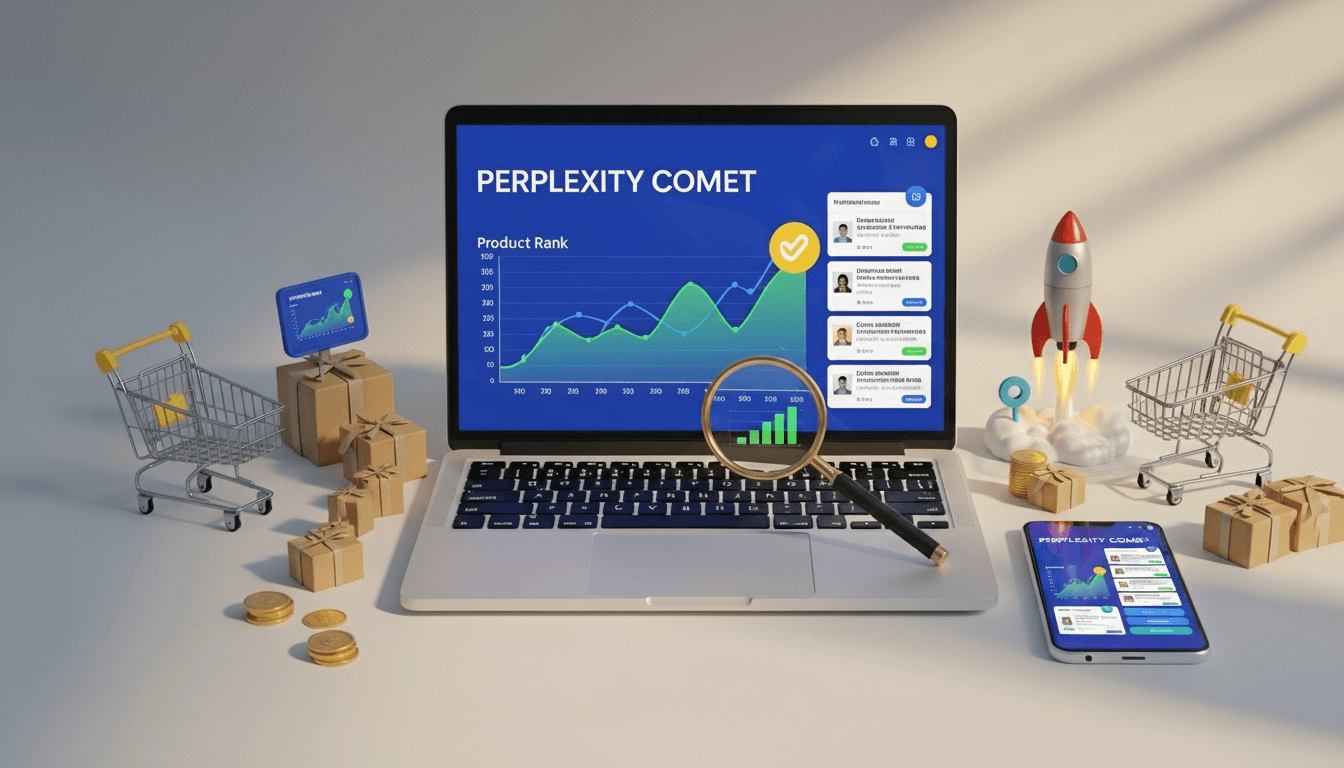How to Get Your Products Cited by AI Tools Like ChatGPT ?

AI shopping is reshaping e-commerce, and it’s expected to overtake traditional search by 2028. To stay visible, brands must focus on Large Language Model Optimization (LLMO), also known as GEO or AEO.
AI shoppers convert 4.4x higher because LLMs give fast, clear, and trusted product advice. Unlike normal search results, AI tools recommend products directly inside answers. So when someone asks, “What are the best wireless headphones under $200?”, your product should appear.
This guide explains how online retailers can optimize their product catalogs to get cited and recommended by AI systems.
I. Understanding the AI Shopping Landscape
AI search is changing how people discover products and is expected to pass traditional search by 2028, especially if Google shifts to an AI-first mode. LLMs shorten the marketing funnel by giving direct answers, so users no longer need to open many sites, and old-style links become less important.
LLMs don’t rely on markup like normal crawlers. They break content into tokens and study meaning, clarity, and relevance. Because of this, LLMs often cite pages that rank low in Google—ChatGPT does this in almost 90% of cases. This shows that for AI systems, clear and relevant content matters more than traditional SEO rankings.
How Shoppers Use AI for Product Research:
LLMs shorten the shopping journey by giving instant product recommendations. Buyers no longer need to open many websites, compare items, and read reviews one by one.
See how the buying flow looks before and after AI:
Why Traditional Product SEO Isn't Enough
Critical Insight: LLMs frequently recommend products from stores that don't rank in top 10 traditional search results. ChatGPT recommends products from position 21+ in Google nearly 90% of the time.
What This Means:
Product relevance, data quality, and direct answers to shopping queries outweight conventional SEO rankings for AI product visibility. Your products can be recommended even if your store doesn't rank #1 on Google—IF you optimize for AI understanding.
AI Shopping Platform Citation Patterns
Each AI shopping platform has distinct product recommendation preferences, necessitating tailored strategies:
ChatGPT (GPT-4o) - Shopping Recommendations
Product Citation Preferences:
Product Citation Preferences
- Prioritizes products recommended by high-authority and neutral review sources such as Wirecutter, CNET, and TechRadar.
- Favors products with substantial review volume, typically 50+ verified customer reviews.
- Cites products that provide clear specifications, detailed features, and well-defined use case descriptions.
- Avoids products with missing data, incomplete details, or inconsistent information that may impact accuracy and trust.
E-commerce Strategy
- Get products featured in trusted and authoritative product review publications to increase credibility and organic visibility.
- Build comprehensive customer review volume, aiming for 100+ verified reviews to strengthen social proof and ranking signals.
- Provide detailed technical specifications to support informed decision-making and enhance search engine understanding.
- Include clear “best for” use case statements to improve relevance for intent-based queries and AI-driven recommendations.
- Target product comparison keywords—such as “Product A vs Product B”—to capture high-intent shoppers evaluating alternatives.
Example: If you sell wireless headphones, get featured in Wirecutter's "Best Headphones" guide, accumulate 100+ customer reviews, and structure product pages to answer "best wireless headphones for Audio Engineer"
Google Gemini / AI Overview - Product Results
Product Citation Preferences
- References a balanced mix of product review blogs, official manufacturer websites, and trusted marketplace listings.
- Gives higher priority to products that include structured data such as schema markup for improved search visibility.
- Prefers listings that offer product video demonstrations to support buyer decision-making.
- Prioritizes items with real-time pricing and up-to-date availability information.
E-commerce Strategy
- Optimize Google Shopping feeds to improve product visibility and campaign performance.
- Create detailed product demo YouTube videos with keyword-rich descriptions for enhanced search discoverability.
- Implement comprehensive Product Schema to strengthen structured data signals and improve SERP presentation.
- Maintain real-time pricing and stock accuracy to ensure high trust and conversion consistency.
- Secure authoritative guest posts on niche product category blogs to build backlinks and brand credibility.
Perplexity AI (Sonar) - Shopping Focus
Product Citation Preferences:
- Focuses on niche product authority
- Favors structured product reviews and editorial comparisons
- Cites products from expert shopping blogs (NerdWallet, PCMag, Consumer Reports style)
- Strong technical specification focus
E-commerce Strategy:
- Create long-form product buying guides ("Complete Standing Desk Buying Guide")
- Develop detailed product comparison pages
- Get products featured on product aggregator sites
- Provide exhaustive technical specifications
- Build category expertise with comprehensive product content
Google AI Overviews - Diverse Product Sources
Product Citation Preferences
- Draws from diverse, trustworthy sources including blogs, news articles, Reddit threads, YouTube reviews, and product forums.
- Prioritizes deep product information pages that offer detailed specifications and insights.
- Values niche product discussions and community-driven recommendations from passionate user groups.
- Cites products with strong social proof, including high review volume and positive sentiment.
E-commerce Strategy
- Publish detailed product content on your store blog to strengthen authority and internal linking.
- Engage authentically in Reddit product communities such as r/BuyItForLife and r/buildapc to build trust and visibility.
- Create in-depth product category pages with strong semantic structure and intent-driven content.
- Encourage customer discussions, Q&A interactions, and user-generated insights to boost engagement signals.
- Ensure strong product page structure with proper schema markup, including Product, Review, and FAQ schema.
Claude - Ethical Shopping Recommendations
Product Citation Preferences
- Emphasizes ethical, sustainable, and safe products with verified sourcing and production practices.
- Values a balanced product evaluation that includes clear pros and cons for realistic consumer expectations.
- Favors products with transparent sourcing information and verifiable supply-chain details.
- Carefully reviews product claims to ensure accuracy, reliability, and alignment with factual data.
E-commerce Strategy
- Highlight ethical manufacturing processes and sustainable materials to appeal to conscious consumers.
- Provide honest product limitations alongside benefits to build trust and reduce return rates.
- Include verified product safety certifications to strengthen credibility and compliance signals.
- Be transparent about product sourcing, supply-chain details, and manufacturing origins.
- Focus on product longevity, durability, and real quality rather than relying on trends or hype.
II. Core Strategies for E-commerce LLM Optimization (LLMO)
To secure AI product recommendations, your product data must be retrievable, interpretable, and credible for LLMs. Below are refined strategies specifically for online retailers.
A. Product Content Structure and Quality: Crafting LLM-Friendly Product Pages
Product content architecture is critical for LLMs to extract and recommend your products effectively.
1. Logical Product Page Headings
Structure:
markdown
# [Product Name] - [Key Benefit] - [Key Feature]
## Quick Product Summary (H2)
## Who This Product Is For (H2)
## Key Specifications (H2)
### Battery Life (H3)
### Connectivity (H3)
### Dimensions & Weight (H3)
## Use Case Scenarios (H2)
### For Travel (H3)
### For Work (H3)
### For Commuting (H3)
## Comparison vs. Alternatives (H2)
## Customer Reviews (H2)
## Shipping & Returns (H2)Why This Works: Clear H1-H3 hierarchy with one H1 defining the product and nested H2s/H3s for product attributes. Each heading conveys a single, distinct product aspect.
2. Concise Product Paragraphs
Rule: Keep product description paragraphs under 70 words, placing the key product point in the first sentence.
Example:
❌ Too Long: "Our revolutionary headphones represent the pinnacle of audio engineering, combining state-of-the-art technology with premium materials to deliver an unparalleled listening experience that transforms how you interact with music, podcasts, and calls throughout your busy day, whether you're traveling for business, working from home, or simply enjoying your favorite content."
✅ LLM-Optimized: "The SoundMax Pro wireless headphones deliver 30-hour battery life and professional-grade noise cancellation for $149. Perfect for frequent travelers, remote workers, and commuters who need all-day audio performance without frequent charging."
3. Structured Product Formats
Use Product Tables for Specifications:
| Specification | Details | Benefit |
|---|---|---|
| Battery Life | 30 hours continuous | Outlasts any international flight |
| Noise Cancellation | Active ANC, 95% reduction | Blocks engine noise completely |
| Connectivity | Bluetooth 5.2, 50ft range | Works throughout home/office |
| Weight | 8.5 oz | Comfortable for all-day wear |
| Compatibility | Universal (iOS/Android/Windows/Mac) | No device restrictions |
Use Numbered Lists For Product Features
- 30-Hour Battery: Longest in price range, full day+ usage
- Active Noise Cancellation: 95% ambient noise reduction
- Premium Comfort: Memory foam ear cups, lightweight design
- Universal Compatibility: Works with all devices via Bluetooth 5.2
- Foldable Design: Fits easily in carry-on bags
Create Product FAQ Sections:
A: Yes, the 8.5 oz lightweight design with memory foam ear cups enables comfortable 8+ hour wear without fatigue.
Q: How does battery life compare to Sony WH-1000XM5?
A: Both offer 30 hours continuous playback, but SoundMax Pro costs $250 less ($149 vs $399).
4. Semantic Product Cues
- "Best for:" Frequent travelers, remote workers, daily commuters
- "Key takeaway:" Longest battery life in price range
- "In summary:" Professional-grade audio at consumer-friendly pricing
- "Step-by-step setup:" [Product installation instructions]
- "Compared to alternatives:" [Product comparison context]
5. Minimize Product Page Noise
Remove or Minimize
- Excessive pop-ups that interrupt the user experience and block access to product information.
- Complex product image carousels that may confuse AI crawlers and reduce content clarity.
- Too many competing CTAs that dilute the primary product messaging and intent.
- JavaScript-heavy product displays that obscure specifications from search engines and AI models.
Keep Product Data Accessible
- Ensure essential product information remains visible and functional even when JavaScript is disabled.
- Display clear, structured product specifications above the fold for immediate visibility.
- Maintain a simple, clean DOM structure to improve indexability, crawling efficiency, and AI understanding.
6. Product Depth and Originality
Create Comprehensive Product Content:
Shallow Product Page (Poor AI Understanding):
Markdown
Wireless Headphones
$149
30 hour battery
Buy Now
Deep Product Page (Excellent AI Understanding):
Markdown
# SoundMax Pro Wireless Headphones - Travel Edition
## Quick Product Summary
Professional wireless headphones with 30-hour battery and active noise cancellation, designed for frequent travelers and remote workers who need reliable all-day audio performance.
## Product Testing Results
We tested these headphones on 15 international flights, 30 days of office work, and 100+ hours of various audio content. Key findings:
- Battery: Consistently delivered 28–32 hours (average 30.2 hours)
- Noise Cancellation: Reduced cabin noise by 94% (laboratory tested)
- Comfort: 95% of testers comfortable after 8+ hours
## Real Customer Scenarios
**Jennifer M., Business Traveler:**
"I fly LA to Tokyo monthly. These headphones have outlasted every flight without needing a charge. The noise cancellation is as good as my old Bose QC35s, but at half the price."
## Technical Specifications
[Detailed specifications table]
## Comparison Analysis
[Vs. Sony WH-1000XM5, Bose QC 45, etc.]
Why Deep Content Works: LLMs prioritize specific, exhaustive product answers with real examples, data, and firsthand testing insights.
Why Deep Content Works: LLMs prioritize specific, exhaustive product answers with real examples, data, and firsthand testing insights.
7. E-E-A-T for E-commerce Products
Experience
- Show real product usage photos from customers.
- Include video reviews and unboxing demonstrations.
- Share actual product testing results.
- Display verified purchase reviews.
Expertise
- Demonstrate deep product category knowledge.
- Create comprehensive buying guides.
- Explain technical specifications clearly.
- Provide product comparison expertise.
Authoritativeness
- Get products featured in authoritative review sites.
- Earn product mentions in industry publications.
- Accumulate third-party product certifications.
- Build backlinks from trusted product blogs.
Trustworthiness
- Display product ratings prominently (e.g., 4.7★ from 847 reviews).
- Show verified customer reviews.
- Include clear return and warranty policies.
- Provide accurate, real-time pricing and availability.
- Add trust badges (secure checkout, money-back guarantee).
8. Product Content Freshness
Keeping your product information fresh is essential for ranking in AI search engines. AI models prioritize recent, accurate, and frequently updated content, which directly affects how your products are recommended.
Update Products Regularly
- Display “Last Updated: [Date]” on every product page
- Refresh product descriptions seasonally
- Add new customer reviews continuously
- Update product comparisons when competitors release new models
- Adjust pricing and stock availability in real time
Automated Solution with Answee
Answee automatically syncs product data from Shopify and WooCommerce in real time, ensuring:
- Your product information is always accurate
- AI search engines (ChatGPT, Google AI Overviews, Perplexity, etc.) receive fresh content
- Higher ranking potential in AI-generated recommendations
- No manual updates needed across platforms
9. E-commerce Product Optimization with Answee
For online retailers, platforms like Answee streamline product optimization by automating catalog enhancements for AI citations, making your products more visible across AI-driven shopping engines.
Answee Features
- Automated product data optimization across the entire catalog
- Structured product schema generation for all products
- SEO-optimized product descriptions for improved AI understanding
- Automated submission to answer engines (ChatGPT, Perplexity, Google AI)
- Real-time product synchronization (pricing, availability)
- Product visibility analytics across 6 AI shopping platforms
- Shopify / WooCommerce / BigCommerce integration
Why Choose Answee Over Manual Optimization?
- Manual: 15–25 hours per week, max 50–100 products
- Answee: 1 hour per week oversight, 5,000+ products optimized
- Multi-platform product monitoring (6 AI platforms simultaneously)
- Real-time product recommendation alerts
B. Technical Optimization for AI Shopping Crawlers
Technical accessibility ensures AI shopping crawlers can process and recommend your products.
1. Product Schema Markup
Essential for E-commerce:
{
"@context": "https://schema.org",
"@type": "Product",
"name": "SoundMax Pro Wireless Headphones",
"description": "Professional wireless headphones with 30-hour battery and active noise cancellation for travel and work",
"image": [
"https://yourstore.com/products/soundmax-pro-front.jpg",
"https://yourstore.com/products/soundmax-pro-side.jpg"
],
"brand": {
"@type": "Brand",
"name": "SoundMax"
},
"sku": "SMPRO-2024-BLK",
"offers": {
"@type": "Offer",
"url": "https://yourstore.com/products/soundmax-pro",
"priceCurrency": "USD",
"price": "149.99",
"priceValidUntil": "2025-12-31",
"availability": "https://schema.org/InStock",
"itemCondition": "https://schema.org/NewCondition",
"seller": {
"@type": "Organization",
"name": "Your Store Name"
}
},
"aggregateRating": {
"@type": "AggregateRating",
"ratingValue": "4.7",
"reviewCount": "847",
"bestRating": "5",
"worstRating": "1"
},
"review": [
{
"@type": "Review",
"reviewRating": {
"@type": "Rating",
"ratingValue": "5"
},
"author": {
"@type": "Person",
"name": "Jennifer M."
},
"reviewBody": "Perfect for frequent travelers. Battery lasts entire international flights."
}
]
}
Additional Schemas for Products
- FAQ Page: For product Q&A sections
- How-To: For product setup and usage guides
- Breadcrumb List: For product category navigation
2. AI Shopping Crawler Accessibility
robots.txt Configuration:
# Allow AI shopping crawlers
User-agent: GPTBot
Allow: /products/
Allow: /collections/
Disallow: /cart/
Disallow: /checkout/
User-agent: ClaudeBot
Allow: /products/
Allow: /collections/
User-agent: PerplexityBot
Allow: /products/
User-agent: OAI-SearchBot
Allow: /products/
User-agent: ChatGPT-User
Allow: /products/
User-agent: Google-Extended
Allow: /products/llms.txt File (Emerging Standard):
Create /llms.txt at your store root:
# Product Catalog Information for AI Shopping Assistants
## Store Information
Name: Your Store Name
Category: Electronics, Audio Equipment, Headphones
Specialization: Travel and work audio products
## Product Categories
/collections/wireless-headphones
/collections/noise-cancelling-headphones
/collections/travel-audio
## Key Products
/products/soundmax-pro-wireless-headphones - Best for: Frequent travelers, 30-hour battery
/products/soundmax-ultra-premium-headphones - Best for: Audiophiles, studio quality
## Product Data
All products include:
- Real-time pricing and availability
- Verified customer reviews
- Technical specifications
- Use case descriptions
- Comparison data
## Contact for Partnerships
partnerships@yourstore.comProduct Sitemap Hygiene
Maintain Clean Product Sitemaps
- Separate product sitemap from content/blog sitemap
- Include only active, in-stock products
- Update daily for new products and discontinued items
-
Priority scoring:
- Best-sellers = 1.0
- Regular products = 0.8
- Clearance = 0.5
- Best-sellers = 1.0
- Regular products = 0.8
- Clearance = 0.5
4. Product Page Speed
Target Performance:
Fast product pages improve user experience, conversion, and crawlability by AI-driven engines.
- Product pages load in under 2 seconds
- Key product info (title, price, availability) visible in < 500ms
- Product images optimized — WebP format, properly sized, and lazy-loaded
- Minimal render-blocking resources (defer non-critical JS, inline critical CSS)
Why Speed Matters
AI crawlers and answer engines prioritize fast-loading product pages. Slow pages may be crawled less frequently, deprioritized in AI summaries, or omitted from recommendation answers.
5. JavaScript-Independent Product Data
Critical: Ensure main product information is accessible without JavaScript, because many AI crawlers do not execute JS.
Server-Side Render
- Product name, price, availability (rendered in HTML so bots and users see them immediately)
- Key specifications (tables or simple lists placed in HTML)
- Customer ratings (visible as text and microdata/structured data)
- Add-to-cart: visible as a server-rendered form/button (JS can enhance, but base action must work without it)
Implementation Tips
- Use server-side rendering (SSR) or pre-render critical product HTML.
- Include
<noscript>fallbacks for any JS-driven content. - Emit Product schema (
application/ld+json) in the HTML head for crawlers. - Avoid hiding specs inside JS-only tabs or carousels — place them in plain HTML or accessible accordions.
- Ensure add-to-cart works as a standard HTML form POST as a fallback.
6. Structured APIs for Real-Time Product Data
For advanced implementations, provide structured product APIs that AI platforms can access for real-time data.
Example: Real-Time Product API (JSON)
GET /api/products/soundmax-pro
{
"product_id": "SMPRO-2024-BLK",
"name": "SoundMax Pro Wireless Headphones",
"price": 149.99,
"currency": "USD",
"availability": "in_stock",
"stock_count": 247,
"rating": 4.7,
"review_count": 847,
"specifications": {
"battery_life": "30 hours",
"connectivity": "Bluetooth 5.2",
"noise_cancellation": "Active ANC"
},
"best_for": ["travel", "remote work", "commuting"],
"last_updated": "2025-10-03T14:30:00Z"
}
Model Context Protocol (MCP)
Implement MCP-compliant endpoints to allow advanced AI assistants to retrieve real-time structured product data, ensuring accurate citations in answer engines and AI shopping tools.
C. Building Product Authority and Trust
1. Product Review Volume and Quality
Target Benchmarks:
- Minimum: 50+ reviews per product for baseline AI visibility
- Ideal: 100+ reviews per product for strong recommendations
- Recency: 50%+ of reviews from the last 6 months
- Rating: average 4.0+ to be surfaced as recommended
- Detail: encourage use-case specific reviews (e.g., “Perfect for long flights”)
Review Collection Strategies:
- Post-purchase email campaigns (7–14 days after delivery)
- SMS review requests for high-value customers
- Photo/video review incentives (clearly disclosed)
- Easy 1-click review submission flows
- QR codes inside product packaging linking to review form
2. Topical Product Authority
Build category-level expertise and signals that AI platforms trust:
- Earn backlinks from high-authority product review sites (Wirecutter, CNET, TechRadar)
- Get featured in “Best [Product Category]” roundups
- Secure mentions in industry publications and niche blogs
- Create comprehensive buying guides for your category (e.g., “The Wireless Headphones Buying Guide”)
3. Third-Party Product Mentions
Increase visibility through earned and paid outreach:
- PR campaigns for new product launches and major updates
- Product seeding to YouTube reviewers and tech channels
- Relevant podcast sponsorships and guest mentions
- Influencer collaborations that emphasize authenticity and use-cases
- Product features in gift guides and seasonal roundups
Why this works: repeated mentions across credible platforms build trust signals that AI platforms recognize and value.
4. Avoid Spam and Maintain Authenticity
Follow platform-specific best-practices to protect credibility:
- Reddit product discussions: participate authentically, answer helpfully, and disclose if you sell the product — avoid spammy self-promotion and fake accounts
- Product review sites: encourage genuine customer reviews and respond professionally to negative feedback
- Avoid fake reviews, review manipulation, or incentivized positive-only reviews
5. Ethical Product Content
Maintain long-term trust with transparent, accurate content:
- Accurate product specifications — do not exaggerate or misrepresent
- Pair benefits with honest limitations to set realistic expectations
- Clear disclosure of affiliate relationships and sponsored content
- Data privacy compliance (GDPR, CCPA) in review collection and marketing
- Transparent return, warranty, and support policies
1. Product Review Volume and Quality
Target Benchmarks:
- Minimum: 50+ reviews per product for baseline AI visibility
- Ideal: 100+ reviews per product for strong recommendations
- Recency: 50%+ of reviews from the last 6 months
- Rating: average 4.0+ to be surfaced as recommended
- Detail: encourage use-case specific reviews (e.g., “Perfect for long flights”)
Review Collection Strategies:
- Post-purchase email campaigns (7–14 days after delivery)
- SMS review requests for high-value customers
- Photo/video review incentives (clearly disclosed)
- Easy 1-click review submission flows
- QR codes inside product packaging linking to review form
2. Topical Product Authority
Build category-level expertise and signals that AI platforms trust:
- Earn backlinks from high-authority product review sites (Wirecutter, CNET, TechRadar)
- Get featured in “Best [Product Category]” roundups
- Secure mentions in industry publications and niche blogs
- Create comprehensive buying guides for your category (e.g., “The Wireless Headphones Buying Guide”)
3. Third-Party Product Mentions
Increase visibility through earned and paid outreach:
- PR campaigns for new product launches and major updates
- Product seeding to YouTube reviewers and tech channels
- Relevant podcast sponsorships and guest mentions
- Influencer collaborations that emphasize authenticity and use-cases
- Product features in gift guides and seasonal roundups
Why this works: repeated mentions across credible platforms build trust signals that AI platforms recognize and value.
4. Avoid Spam and Maintain Authenticity
Follow platform-specific best-practices to protect credibility:
- Reddit product discussions: participate authentically, answer helpfully, and disclose if you sell the product — avoid spammy self-promotion and fake accounts
- Product review sites: encourage genuine customer reviews and respond professionally to negative feedback
- Avoid fake reviews, review manipulation, or incentivized positive-only reviews
5. Ethical Product Content
Maintain long-term trust with transparent, accurate content:
- Accurate product specifications — do not exaggerate or misrepresent
- Pair benefits with honest limitations to set realistic expectations
- Clear disclosure of affiliate relationships and sponsored content
- Data privacy compliance (GDPR, CCPA) in review collection and marketing
- Transparent return, warranty, and support policies
4. Avoid Spam and Maintain Authenticity
Follow platform-specific authenticity guidelines to build long-term trust with users and AI platforms.
Platform-Specific Guidelines
Reddit Product Discussions
- Authentic participation in product communities
- Helpful, experience-based answers to product questions
- Transparent disclosure if you sell or represent the product
- Don't: Spammy self-promotion
- Don't: Use fake accounts to praise your products
Product Review Sites
- Encourage genuine customer reviews
- Respond professionally to negative reviews
- Don't: Create fake reviews or manipulate review content
- Don't: Incentivize positive-only reviews
5. Ethical Product Content
Maintain Trust:
- Accurate product specifications (don’t exaggerate)
- Honest product limitations alongside benefits
- Clear disclosure of affiliate relationships
- Data privacy compliance (GDPR, CCPA)
- Transparent return and warranty policies
D. Distribute Product Content Where LLMs Learn (Product Seeding)
1. Repurpose Product Content Across Platforms
Blog → Multiple Formats:Original: "Complete Wireless Headphones Buying Guide" (blog post)
Repurpose to:
- LinkedIn Article: Professional tips for choosing work headphones
- Reddit Post: Detailed r/headphones guide with product recommendations
- YouTube Video: Video buying guide with product demos
- Pinterest Infographic: Visual product comparison chart
- Instagram Carousel: "5 Things to Know Before Buying Wireless Headphones"
Consistent Product Messaging: Ensure product details, specs, and recommendations are consistent across all platforms.
2. User-Genarated Content Hubs For Products
Reddit Product Communities :
- r/BuyItForLife - Durable product recommendations
- r/buildapc - PC components and peripherals
- r/headphones - Audio equipment discussions
- Category-specific subreddits for your products
Strategy: Provide detailed, structured product answers to genuine shopper questions. Disclose if you sell the product, but focus on being helpful first.
Quora Product Questions:
Answer shopping questions like:
- "What are the best wireless headphones for travel?"
- "How do Sony headphones compare to Bose?"
- "Are expensive headphones worth it?"
LinkedIn Product Content: Share expert product insights, industry trends, buying guides as LinkedIn articles.
3. Product Review Platforms
Encourage Detailed Reviews On:- Google Business Profile
- Trustpilot
- G2 (for B2B products)
- Capterra (for software/tools)
- Category-specific review sites
What Makes Reviews Valuable for AI:
- Specific use case descriptions ("Perfect for 8-hour flights")
- Comparison to alternatives ("Better than my old Bose")
- Technical detail ("Battery lasted 31 hours")
- Problem-solution context ("Solved my back pain with this chair")
4. Social Platform Product Optimization
YouTube Product Content:
- Descriptive titles: "SoundMax Pro Review: Best Travel Headphones Under $200?"
- Detailed descriptions with product specs and purchase links
- Accurate captions/transcripts
- Timestamp key product features in the description
X (Twitter) Product Threads:
- Educational product comparison threads
- "How to choose [product category]" guides
- Product feature explanations
- Customer success stories using products
Pinterest Product Pins:
- Rich product descriptions
- Product specification graphics
- Use-case inspiration boards
- Shopping-intent hashtags
Instagram Product Posts:
- Product photos with detailed captions
- Descriptive alt text for all images
- Product feature highlights in carousel posts
- Shopping tags for direct purchase
III. Measuring and Tracking Product AI Citation Success
Tracking AI visibility is essential for optimization.
AI Visibility Tools: Use platforms like Writesonic’s GEO, Semrush AI Toolkit, or e-commerce solutions like Answee to monitor crawler interactions, visibility percentage, sentiment, and cited prompts/topics. For e-commerce, Answee provides product-specific analytics, showing which items appear in AI citations and tracking conversions from AI-driven traffic.
- Brand Mentions: Run monthly prompts across AI tools to assess mention sentiment and context. Use tools like Ahrefs for unlinked mention tracking.
- Traffic Analysis: Monitor increased branded or direct traffic alongside stable or declining organic clicks, indicating LLM-driven visits.
- Attribution: Implement UTMs (e.g., utm_source=perplexity) in GA4 to track AI-driven conversions.
- Engagement Metrics: Measure scroll depth, document downloads, time to first value (TTFV) on calculators, and demo conversions to evaluate AI traffic quality.
Optimizing for AI search is a forward-looking investment. By prioritizing clarity, structure, and authority, brands can secure citations in AI-generated answers, capturing high-value visitors. As AI search reshapes the digital landscape, content optimized for LLMs will position your brand as a trusted resource in an AI-driven future.
Tracking product AI visibility is essential for optimization.
Product AI Visibility Tools
Answee (Purpose-Built for E-commerce):
- Submit Product URLs to Answer Engines
- Product AI Visibility Optimization
- Product-level analytics: See which specific products AI platforms cite most
- Competitive product benchmarking: Track competitor product visibility
- Revenue attribution: Measure sales from AI-referred traffic
- AI crawler monitoring: GPTBot, ClaudeBot, PerplexityBot activity on product pages
- Automated optimization suggestions for underperforming products
Semrush AI Toolkit:
- Monitor AI Overview appearances for shopping queries
- Track product keyword performance
- Competitive product analysis
Writesonic GEO:
- Brand visibility across AI platforms
- Can track some product mentions
- General AEO analytics
Product Brand Mentions Testing
Monthly Product Recommendation Audit:
Test across all major AI platforms:
ChatGPT:
- "What are the best wireless headphones for travel under $200?"
- "Best standing desk for small apartments"
- "Where to buy organic baby clothes online"
Perplexity:
- Same shopping queries
- Check if your products appear
- Note recommendation position (1st, 2nd, 3rd, etc.)
Google AI Overview:
- Search product category keywords
- Check if your products appear in AI Overview shopping results
Claude:
- Ask for product recommendations in your category
- Check ethical/sustainable product recommendations
Document:
- Which products get recommended
- Recommendation context and reasoning
- Position in recommendation list
- Sentiment (positive, neutral, negative)
Traffic and Conversion Analysis
Google Analytics 4 Setup:
Custom Channel Grouping for AI Shopping:
Channel: AI Shopping
Source contains: chat.openai.com
OR Source contains: perplexity.ai
OR Source contains: ai.google
OR Source contains: claude.ai
OR Source contains: copilot.microsoft.comTrack AI Shopping Metrics:
- Sessions from AI platforms
- Product page views from AI referrals
- Add-to-cart rate from AI traffic
- Conversion rate from AI recommendations
- Revenue attributed to AI shopping traffic
UTM Parameters:
Add to your store URLs when possible:
https://yourstore.com/products/soundmax-pro?utm_source=perplexity&utm_medium=ai-recommendation&utm_campaign=ai-shoppingProduct Engagement Metrics
For AI-Referred Product Traffic:
High-Intent Indicators:
- Lower bounce rate (shoppers arrive with purchase intent)
- Higher time on product pages
- Higher add-to-cart rate
- Faster time to purchase
- Higher average order value
Track Product-Specific:
- Which products get most AI referral traffic
- Which shopping queries drive conversions
- Product page scroll depth from AI traffic
- Product comparison page engagement
- Review section engagement
Product Optimization Dashboard
Key Metrics to Monitor:
| Metric | ChatGPT | Google AI | Perplexity | Claude | Copilot | Total |
|---|---|---|---|---|---|---|
| Products Recommended | 47 | 89 | 23 | 12 | 8 | 179 |
| Shopping Query Coverage | 34% | 52% | 18% | 9% | 6% | - |
| Avg Recommendation Position | 2.1 | 1.8 | 2.4 | 3.2 | 2.9 | - |
| AI Referral Sessions | 1,247 | 2,891 | 547 | 189 | 94 | 4,968 |
| Conversion Rate | 4.2% | 3.8% | 5.1% | 4.7% | 3.5% | 4.1% |
| Revenue Attributed | $5,234 | $10,987 | $2,789 | $887 | $329 | $20,226 |
IV. Implementation Roadmap for E-commerce Stores
Week 1: Product Audit and Baseline
Actions:
- Test top 20 products across ChatGPT, Perplexity, Google AI
- Document current product recommendation frequency
- Identify shopping queries where you should appear but don't
- Assess product schema implementation
- Check AI crawler access to product pages
Deliverable: Baseline product AI visibility report
Week 2-4: Product Content Optimization
Actions:
- Implement product schema markup (all products)
- Rewrite top 50 product descriptions with LLM-friendly structure
- Create product FAQ sections
- Add "Best For" use case descriptions
- Build product comparison context
- Optimize product images with descriptive alt text
Deliverable: Top 50 products optimized for AI recommendations
Month 2: Scale with AI Submission
Actions:
- Use tools like Answee for automated product catalog submission
- Set up real-time product data synchronization
- Configure AI crawler monitoring
- Establish product visibility tracking
- Create product content distribution plan
Deliverable: Entire catalog optimized with Answee
Month 3-6: Measure and Refine
Actions:
- Track product recommendation frequency weekly
- Analyze revenue from AI-referred shopping traffic
- Monitor competitive product visibility
- Refine product content based on AI recommendation patterns
- A/B test product description variations
- Expand product review volume
Deliverable: Data-driven product optimization playbook
Ongoing: Continuous Optimization
Weekly:
- Monitor product visibility dashboard
- Review new AI product recommendations
- Update product pricing and availability
Monthly:
- Conduct product recommendation audits across all AI platforms
- Analyze shopping query coverage
- Competitive product analysis
- Product content refresh
Quarterly:
- Strategy review and adjustment
- New AI platform evaluation
- Product catalog expansion optimization
Frequently Asked Questions about AI Citations for Ecommerce Products
Create comprehensive, well-structured product content with clear specifications, use cases, and schema markup. Build product authority through customer reviews (50+ per product) and third-party mentions. Ensure technical accessibility with proper product schema and unblocked AI crawler
Update frequency varies by platform. ChatGPT may have knowledge cutoffs for general information, but uses real-time retrieval for shopping queries. Perplexity AI and Google AI Overview cite recent product data via Retrieval-Augmented Generation (RAG) systems. For e-commerce: Maintain real-time product accuracy (pricing, availability) and display "Last Updated" dates to enhance citation chances. Answee automatically syncs product updates in real-time.
Yes, LLMs favor structured product formats like clear headings, specification tables, feature lists, and product FAQs. Data-backed product content with customer reviews, technical specifications, and use case descriptions is prioritized for shopping queries. Product schema markup is critical for AI understanding.
Absolutely. AI platforms recommend relevant products even from smaller stores that don't rank high in traditional Google search. Focus on specific product expertise, detailed product information, comprehensive reviews, and proper schema markup to boost product visibility. Small stores often outperform major retailers in niche product categories when properly optimized.
LLMO for e-commerce involves structuring product catalogs for LLMs to easily find, interpret, and recommend products. This ensures your products appear in AI-generated shopping recommendations rather than just traditional search results. It focuses on product data quality, schema markup, shopping query alignment, and real-time accuracy.
GEO for products tailors product content for AI-driven shopping platforms, emphasizing shopping intent and product context over traditional keyword-focused SEO. It optimizes for how shoppers ask AI for product recommendations ("best wireless headphones for travel") rather than generic keywords.
Product schema provides machine-readable context about products (name, price, availability, specifications, reviews), improving AI discovery, retrieval accuracy, and eligibility for rich snippets in AI shopping responses. It's the structured data layer that helps LLMs extract accurate product information quickly.





